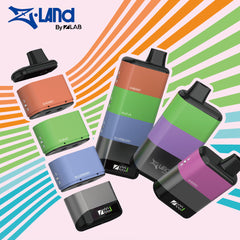The rise of e-cigarettes has brought with it a wave of curiosity and concern. What exactly is in an e-cigarette, and will it impact your health? Since their debut in the mid-2000s, e-cigarettes have rapidly become an alternative to traditional smoking, boasting a range of flavors and a supposedly safer profile.
But what lies within the vapor?
We’ll unpack the common ingredients of e-cigarettes, the hidden dangers of some of those chemicals, the potential side effects, and why, despite the risks, people continue to use them.
At a glance:
What’s Typically in an E-Cigarette?
At first glance, e-cigarettes seem straightforward: a sleek device that produces vapor for inhalation. However, the components inside are far more complex. The typical e-cigarette has three main parts: a battery, a heating element (atomizer), and an e-liquid or vape juice. While the hardware might vary in sophistication, the real intrigue lies in the e-liquid’s ingredients.
Propylene Glycol (PG) and Vegetable Glycerin (VG)
Propylene glycol and vegetable glycerin form the base of most e-liquids. These colorless, odorless liquids create a vapor that mimics smoke when heated. PG is the flavor carrier and is also responsible for a throat hit similar to traditional cigarettes. VG is thicker and contributes to vapor production, leading to those large clouds many vapers enjoy.
Both PG and VG are generally considered safe for consumption. They are common in food products, cosmetics, and pharmaceuticals. However, the long-term effects of inhaling these compounds are yet to be seen. PG, in particular, can irritate the airways in some users.
Nicotine
Nicotine is the addictive component in both traditional cigarettes and many e-cigarettes. While some e-liquids are nicotine-free, many users still prefer a dose of nicotine to satisfy their cravings. Nicotine in e-cigarettes is absorbed into the bloodstream quickly and acts as a stimulant. However, its addictive nature poses significant risks, including an increased chance of heart disease and high blood pressure.
It’s important to note that nicotine in e-cigarettes can come in two forms: freebase nicotine and nicotine salts. Freebase nicotine is typically harsher on the throat, while nicotine salts, found in higher concentrations, are smoother, making them appealing to users who want a stronger nicotine hit without the harsh sensation.
Flavorings
One of the biggest attractions of e-cigarettes is the wide variety of flavors. From fruit and candy to desserts and tobacco, the range of e-liquid flavors seems endless. These flavorings are often food-grade and approved for ingestion, but that doesn’t necessarily mean they’re safe to inhale.
Research has shown that some flavoring chemicals, such as diacetyl, can cause harm when inhaled and has been linked to a condition called “popcorn lung. Despite being safe for oral consumption, the respiratory system processes substances differently, and long-term exposure to certain flavoring compounds may lead to lung damage.
Other Additives
In addition to the main components, e-liquids can contain a range of additives that affect the flavor, color, and texture of the vapor. Some may include sweeteners, colorants, or cooling agents like menthol to enhance the vaping experience. However, like flavorings, these additives may also pose health risks when inhaled.
What Are Some of the More Dangerous Chemicals Often Found in E-Cigarettes?
While the ingredients listed above are standard in most e-cigarettes, there are concerns about harmful chemicals that might also be present. These chemicals can result from the heating process or contamination during manufacturing. Let’s take a closer look at some of the more dangerous compounds found in e-cigarettes.
Formaldehyde
Formaldehyde, a known carcinogen, has been detected in some e-cigarette vapor, particularly when devices are used at high temperatures. This compound forms when the liquid overheats or “dry hits” occur, leading to the decomposition of PG and VG. Inhaling formaldehyde can increase the risk of cancer and irritate the eyes, throat, and skin.
Acetaldehyde
Another potentially harmful chemical, acetaldehyde is produced during the combustion of e-liquids. Like formaldehyde, acetaldehyde is a probable carcinogen and can cause respiratory irritation. Continuous exposure to this chemical may elevate the risk of lung diseases over time.
Heavy Metals (Nickel, Lead, and Chromium)
Some studies have found traces of heavy metals such as nickel, lead, and chromium in e-cigarette vapor. These metals can originate from the heating coils or other parts of the device and may leach into the vapor during the heating process. Exposure to heavy metals can have detrimental effects on the nervous system, kidneys, and respiratory system.
Volatile Organic Compounds (VOCs)
VOCs are chemicals that easily evaporate into the air and can be found in both e-liquid ingredients and the vapor. These compounds include benzene and toluene, both of which are associated with long-term health risks like cancer, liver damage, and central nervous system disorders.
Diacetyl
As mentioned earlier, diacetyl is a flavoring agent linked to bronchiolitis obliterans, commonly referred to as "popcorn lung." Although many e-liquid manufacturers have removed diacetyl from their products following these findings, some e-liquids still contain this harmful chemical. Inhaling diacetyl can cause severe and irreversible lung damage.
What Are Some of the Potential Side Effects of Using E-Cigarettes?

With the presence of these chemicals, it's no surprise that using e-cigarettes can lead to a variety of side effects. These effects can range from mild and short-term to severe and long-lasting, depending on the frequency of use, the ingredients in the e-liquid, and individual susceptibility.
Respiratory Issues
Vaping is often marketed as a healthier alternative to smoking, but it can still harm your lungs. E-cigarette users may experience coughing, shortness of breath, and irritation of the airways. Long-term use may lead to more serious conditions like chronic bronchitis, asthma exacerbation, or even lung disease.
Nicotine Addiction
Nicotine addiction is one of the most common side effects of e-cigarette use. As with traditional cigarettes, nicotine is highly addictive and can lead to dependency. Many e-cigarette users may find themselves vaping more frequently to satisfy their nicotine cravings, increasing the likelihood of long-term addiction.
Increased Heart Rate and Blood Pressure
Nicotine is a stimulant, and its use can lead to increased heart rate and blood pressure. This can put added strain on the cardiovascular system, raising the risk of heart disease, stroke, and other cardiovascular complications over time.
Dry Mouth and Dehydration
PG and VG, the primary ingredients in e-liquids, are known to absorb moisture. As a result, frequent vaping can lead to dry mouth, dehydration, and throat irritation. Users may experience a persistent dry sensation in the mouth, increased thirst, and even hoarseness in their voice.
Popcorn Lung
As mentioned earlier, exposure to diacetyl can cause a condition known as popcorn lung. This irreversible lung disease results in scarring of the airways, leading to breathing difficulties, wheezing, and chronic coughing.
Despite the Potential Safety Risks, Why Do Some People Use E-Cigarettes?

Given the potential risks, why do people continue to use e-cigarettes? The answer lies in a combination of factors, including perceived benefits, social influences, and the appeal of vaping culture.
Perception of Reduced Harm
One of the main reasons people use e-cigarettes is the perception that they are less harmful than traditional cigarettes. Since e-cigarettes don’t involve the combustion of tobacco, many users believe they are avoiding the dangerous chemicals found in cigarette smoke. While e-cigarettes may reduce exposure to certain toxicants, they are not entirely risk-free.
Nicotine Replacement
For many, e-cigarettes serve as a way to manage nicotine cravings without resorting to smoking. Smokers looking to quit often turn to vaping as a way to gradually reduce their nicotine intake. E-cigarettes provide a familiar sensation without the harmful tar and other chemicals associated with smoking.
Flavor Variety and Customization
The wide range of flavors available in e-liquids is a major attraction for users, particularly younger vapers. From fruity concoctions to dessert-inspired blends, the ability to customize the vaping experience makes it more appealing. The act of vaping can become a sensory experience beyond just nicotine consumption.
Social Appeal and Subculture
Vaping has developed its own subculture, with enthusiasts gathering online and in person to share their experiences, techniques, and equipment. Cloud-chasing, where vapers aim to produce the largest vapor clouds, and vaping competitions have become part of this growing community. The social aspect of vaping can make it an attractive habit, especially for younger users.
Conclusion
E-cigarettes offer a modern alternative to traditional smoking, blending the appeal of flavors, vapor production, and nicotine control. However, despite being marketed as a safer option, they are not without risks.
Understanding what’s inside an e-cigarette — from the base ingredients like propylene glycol and vegetable glycerin to harmful chemicals such as formaldehyde and diacetyl — is essential for making informed decisions about your health.
One way to mitigate some of these risks is by carefully vetting the ingredients in your vape products. Choosing reputable brands that provide full transparency about their e-liquid contents can reduce the chances of inhaling harmful chemicals.
Look for vapes with e-liquids that avoid additives like diacetyl and limit exposure to potentially dangerous heavy metals or volatile organic compounds. Additionally, selecting nicotine-free or low-nicotine options can help manage the risk of addiction.
While vaping still carries its own set of health concerns, being proactive about the products you use and understanding what’s in them can make a difference. Always research the brands you trust and prioritize those that emphasize safety and quality in their manufacturing processes.
At Ziip Stick, we are one of the few disposable vape companies to receive a filing and acceptance letter from the FDA for a Premarket Tobacco Application (PMTA). To get this PMTA status, we submitted hundreds of thousands of pages of lab results to show the FDA — and you — that we only use high-quality, safe materials in our vapes.








Leave a comment